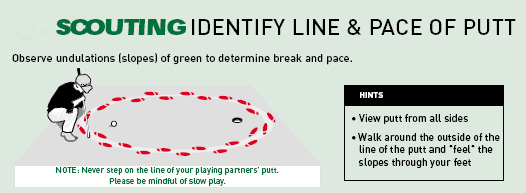
Here we have provided a basic pre-shot routine that can be used with your students to help them have a solid base which they can build on. Feel free to add to this or take away from this as you see fit.

In this part of the routine, the player is taking in all the available information and studying the green, in addition to observing how his fellow competitors’ putts react on the green. This is the time to read the green and determine the green’s speed. This information is then ready for the brain to start processing and planning on what to do with it and what messages to send to the body.

Once the player has made up his mind on the line and break of the putt, as well as the pace at which the ball is going to travel to the hole, it is time to prepare.
As pictured above, the player can stand behind or to the side of the ball (whichever is most comfortable), and it is in this position while taking practice swings that should bring together the image of the ball traveling toward the hole on the selected line at the chosen pace. This integration of the picture in the mind’s eye with the putt’s physical moves is what is crucial here.
It is important to understand that the practice swings taken at this point are not to obtain the perfect stroke and are not about the mechanics of the movement. Rather they are to “feel” the stroke. Many students either do not take any practice swings because they are not sure what exactly they should do, or if they do, they are watching the putter head making sure that the stroke is “correct.” We suggest that your students look at the hole when they take their practice swings so as to avoid obsessing over the mechanics of the stroke.
In this most critical part of the routine the student is connecting to the target. He is feeling the line, the movement of the stroke and seeing the ball travel toward the hole and hearing it fall in. This is a rich, vivid preparation for success.

Once this process has been completed and the student feels prepared, it is time to commit to the stroke. The student steps over an imaginary line of commitment and addresses the ball in a consistent manner. This commitment is important, because it removes any doubts or fears. The student is ready to make a positive putt.

In the action mode, the putter head is aligned with the target line and the student traces the line to and from the hole with his eyes, finally resting and locking them on a spot behind the ball for the duration of the putt. He then makes a confident, rhythmic putt.
Once in this mode, if any doubts creep in while the student is standing over the ball, he must return back over the line of commitment and make any adjustments to the plan.

The result of the putt and how the student reacts to its outcome is as important as the preparation. If the student has done as it says above, then he should maintain a positive outlook and attitude. Alternatively if the player blames the stroke or questions the technique, then the next putt becomes riddled with doubt about his ability to perform your stroke.
If your student did not perform the intended stroke, we suggest that he review if something pulled him out of the routine or positive state of mind and watch for patterns in the misses. That way he can make adjustments and save strokes during this round.
In order to reap the most benefit from this approach, the student must follow the routine and its physical and mental steps consistently and in a disciplined fashion. By doing this, the student will reinforce success and know exactly what he did to create that positive putt.
Using this guideline or template, putting actually becomes much easier. And even if the student misses a putt, it will be possible to smile or laugh, because he will know he did all he could do to succeed. And you can’t ask for much more than that.


